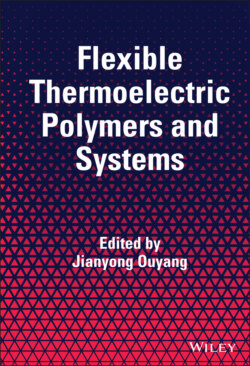Читать книгу Flexible Thermoelectric Polymers and Systems - Группа авторов - Страница 19
1.1.5.2 Charge Carrier Mobility
ОглавлениеThe conduction electrons in metals are the valence electrons of metal atoms. The conduction electrons can be scattered by the lattice consisted of metal cations, and the lattice scattering lowers the electron mobility. Because of the much higher ion concentration in metals than in inorganic semiconductors, metals usually have a much lower charge carrier mobility than inorganic semiconductors. The charge carrier mobility of inorganic semiconductors is mainly affected by impurities, defects, and lattice vibration. A doping atom can be considered as an impurity, and it forms a scattering center for the charge carriers. As a result, doping lowers the charge carrier mobility. Therefore, the charge carrier mobility of inorganic semiconductor and conducting polymers usually decreases with the increasing doping level.
Different from metals and inorganic semiconductor that can be prefect crystals, a conducting polymer cannot have 100% crystallinity. There are both amorphous and crystalline domains in conducting polymers (Figure 1.13). The amorphous domain has a conductivity much lower than that of the crystalline domain. The charge transports include intrachain, interchain, and inter‐domain processes. The interchain charge transport is usually the dominant process. Thus, the charge carrier mobility of conducting polymers strongly depends on the crystallinity. High crystallinity can facilitate the interchain charge transport, and thus give rise to high charge carrier mobility. A conducting polymer with the same chemical composition can have conductivities spanning several orders by magnitude.
Figure 1.13 (a) Intrachain, (b) interchain, and (c) inter‐domain charge transports in conducting polymers.
The crystallinity of some conducting polymers can be increased through post treatment. As a result, the conductivity can be enhanced by several orders of magnitude. When a chemical is used for the post treatment, the post treatment method is usually called “secondary doping.” Secondary doping has been extensively reported for solution‐processable conducting polymers including polyaniline and PEDOT:PSS [15–19]. Polyaniline doped with a large counter anion like camphorsulfonic acid (HCSA) can be dispersed in organic solvent such as m‐cresol and chloroform [20]. The solvent significantly affects the crystallinity and the conductivity of polyaniline:HCSA (PANi:HCSA) because it can affect the conformation of the polymer chains in solution. When a PANi:HCSA film is prepared from chloroform, its conductivity is only 10−1 S cm−1, while it can be >100 S cm−1 when it is obtained from m‐cresol. This difference in conductivity is attributed to the effect of the solvents on the crystallinity of polyaniline. As shown in Figure 1.14, there is a strong absorption in the infrared range for the PANi:HCSA film cast from its m‐cresol solution [15]. This suggests a high crystallinity and the delocalization of the charge carrier. Instead, only a band appears in the near infrared (NIR) range when chloroform is used as the solvent. This is consistent with the low crystallinity.
Figure 1.14 UV–visible–NIR absorption spectra of PANi:HCSA films casted from solutions with (a) m‐cresol or (b) chloroform as the solvent, respectively.
Source: MacDiarmid and Epstein [15]. © Elsevier.
Figure 1.15 Conductivity of PEDOT:PSS after secondary doping with H2SO4.
Source: Xia et al. [21]. © John Wiley & Sons.
A couple of secondary doping methods were also reported for PEDOT:PSS. PEDOT:PSS can be dispersed in water [17–19]. The conductivity of an as‐prepared PEDOT:PSS film is only 10−1 S cm−1, and it can be significantly enhanced by secondary doping. The chemicals for the secondary doping can be organic solvents like dimethyl sulfoxide (DMSO), ethylene glycol (EG) and even methanol, cosolvent of water and organic solvents, aqueous or organic solutions, ionic liquids, and acids. Particularly, the conductivity of PEDOT:PSS can be enhanced from 10−1 S cm−1 to higher than 3000 S cm−1 through a post acid treatment [21–24]. The conductivity enhancement is ascribed to the partial removal of the insulating PSSH from PEDOT:PSS and the conformational change of PEDOT from coil to expanded‐coil or linear structure. Less PSSH chains and linear PEDOT conformation can lead to high crystallinity and thus high conductivity.
Mechanical stretching can orient polymer chains along the tensile direction and thus increase the crystallinity. It has been used to increase the conductivity of conducting polymers as well [25, 26]. For example, it can increase the conductivity of polyacetylene up to 105 S cm−1.
